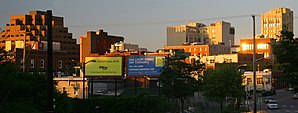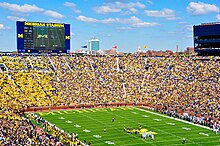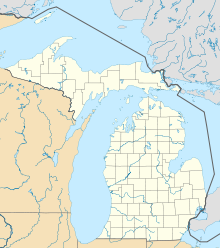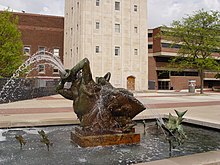Ann Arbor
| Ann Arbor | ||
|---|---|---|
| Nicknames : A², A-2, Tree Town, Ace Deuce, the Deuce | ||
 Ann Arbor horizon |
||
| Location in Michigan | ||
|
|
||
| Basic data | ||
| Foundation : | 1824 | |
| State : | United States | |
| State : | Michigan | |
| County : | Washtenaw County | |
| Coordinates : | 42 ° 17 ′ N , 83 ° 44 ′ W | |
| Time zone : | Eastern ( UTC − 5 / −4 ) | |
|
Inhabitants : - Metropolitan Area : |
120,782 (as of 2016) 364,709 (as of 2016) |
|
| Population density : | 1,725.5 inhabitants per km 2 | |
| Area : | 71.7 km 2 (approx. 28 mi 2 ) of which 70 km 2 (approx. 27 mi 2 ) are land |
|
| Height : | 256 m | |
| Postcodes : | 48103, 48104, 48105, 48106, 48107, 48108, 48109, 48113 | |
| Area code : | +1 734 | |
| FIPS : | 26-03000 | |
| GNIS ID : | 0620133 | |
| Website : | www.a2gov.org | |
| Mayor : | Steve Powers | |
Ann Arbor is a city and the seat of the county government of Washtenaw County in the US state of Michigan . The city is located on the Huron River about 40 miles west of Detroit . On a total area of 71.7 km² (of which 70 km² land and 1.7 km² water area) live 120,782 inhabitants (as of 2016), which corresponds to a population density of 1725 inhabitants / km², making Ann Arbor the sixth largest city in Michigan.
Ann Arbor is shaped by the University of Michigan , which is centrally located in the city and around which numerous research institutes, such as the pharmaceutical company Pfizer , have settled. The university and its affiliated clinics are by far the largest employer in the city, and Michigan Stadium , where the Michigan Wolverines football team plays their home games, is the largest stadium in the United States by seats. The name of the city is also internationally known through the Ann Arbor model of empirical electoral research developed by social scientists at the University of Michigan in the 1950s, as well as through the globally recognized Ann Arbor classification of the Hodgkin and non-Hodgkin , created in 1971 Lymphoma .
history
19th century
Ann Arbor was founded in 1824 by John Allen and Elisha Walker Rumsey, who both bought land in the area and looked for growth. The area around the Great Lakes experienced its first large immigration from the east coast at this time, as the Erie Canal was under construction and was completed in 1825. On May 25, 1824, the place was registered within Wayne County under the name "Annarbour" for the first time. Founders Allen and Rumsey named the place after their wives, both of whom were named Ann, and after an oak grove that was on the 260 acres of land they had purchased from the federal government for $ 800.
In 1827, Ann Arbor (as it was then spelled) became the administrative seat of Washtenaw County, and in 1833 the place was incorporated as a village. Than in 1835 between the US state of Ohio came and the US territory Michigan for conflict over a strip of territory the city of Toledo , contains - in the Toledo War - appeared in September this year a meeting of representatives of the Michigan Territory in Ann Arbor together. She turned down US President Andrew Jackson's offer that Michigan could become a state - on the condition that the area around Toledo be ceded to Ohio and Michigan in return receive part of the Upper Peninsula (which was then considered worthless) . As the conflict subsequently escalated, another meeting in Ann Arbor (called the "Frostbitten Convention") met in December 1836 and accepted the offer.
In 1837, in which Michigan became the 26th state in the United States, a site that belonged to the place was designated as the headquarters of the University of Michigan . In 1839, the Michigan Central Railroad reached the place, which subsequently became an important traffic junction on the Toledo route.
In the context of the dispute over the slave question in the USA, Ann Arbor became an important center for abolitionists . In November 1836 the Michigan Antislavery Society was founded in Ann Arbor and from April 1841 it appeared here, edited and published. a. by Rev. Guy Beckley , Signal of Liberty abolitionist newspaper . Accordingly, Ann Arbor became an important station on the Underground Railroad , the network that helped slaves from the south escape to the north of the country and often further to Canada. After the end of the American Civil War (1861–1865), numerous blacks returned to Michigan from neighboring Canadian Ontario and settled among others. a. also in Ann Arbor.
After the civil war, the population of the place rose only slowly, and it was not until the 1880s that there was strong growth through immigration from u. a. Germany, Canada, Greece, Italy, Russia and Poland. During the 19th century, a particularly large number of Swabians emigrated to Ann Arbor. The first Lutheran church in Michigan was founded in 1833 by the Württemberg Friedrich Schmid near Ann Arbor.
20th century

At the beginning of the 20th century, a good third of the population of Ann Arbor was of German or German-speaking descent, and there were numerous German-speaking clubs, churches, publications, and shops. This changed radically with the First World War , when there was pronounced anti-German propaganda in the USA before and with the entry into the war in 1917. As a result, numerous professors of German origin at the University of Michigan were dismissed, most German-language publications were discontinued, and German associations and companies were renamed. After the end of the First World War, as part of the Great Migration, more and more Afro-Americans, who mostly immigrated from the so-called Deep South of the USA, settled in and around Ann Arbor.
During the Second World War , a Ford- operated factory, the Willow Run Factory , was built near Ann Arbor to produce B-24 Liberator bombers . Over 8,600 machines were manufactured here. After aircraft production ended in 1945, the Kaiser Motors car company took over the plant.
In 1960, both candidates, John F. Kennedy and Richard Nixon , made major speeches in Ann Arbor during the US presidential election . Kennedy announced his proposal to form a Peace Corps on October 14, 1960 in front of the Michigan Union building . On May 22, 1964, President Lyndon B. Johnson presented his Great Society initiative in a speech to graduates from the University of Michigan .
During the 1960s, Ann Arbor, and especially its university, became an important place for the civil rights movement and for initiatives against the Vietnam War . In 1960, the University of Michigan hosted the first large gathering of Students for a Democratic Society , and in 1968 the White Panther Party was founded in An Arbor , which, based on the Black Panther Party , campaigned radically for social change. In June 1969, protesters and police rioted around the university. On December 10, 1971, John Lennon and Yoko Ono led the Free John Now Rally in front of 15,000 people in Ann Arbor's Crisler Arena, demanding the release of anarchist John Sinclair three days later. In the 1970s, the Human Rights Party , which John Sinclair and other members of the White Panther Party joined, gained influence in Ann Arbor and the surrounding area. At times the party provided two members of the city council. Under pressure from the Human Rights Party, Ann Arbor legalized the private possession of small amounts of marijuana and passed an anti-discrimination policy. A party councilor, Nancy Wechsler, declared in 1972 that she was a lesbian - making her the first openly homosexual elected official in the United States.
During the 1960s and 1970s, numerous important rock and pop musicians and bands came from or lived in Ann Arbor, including the MC5 , Alice Cooper , Iggy Pop , George Clinton , Bob Seger and Mitch Ryder . Madonna studied at the university in the late 1970s.

In Ann Arbor, a total of 37 structures and sites are listed on the National Register of Historic Places (as of March 1, 2020), including the Michigan Theater .
Location and cityscape

Data from the United States Census Bureau , according to the area of the city includes 74.33 square kilometers, of which 72.08 square kilometers land and 2.25 km 2 of water surfaces. Ann Arbor is about 35 miles west of Detroit on the Huron River .
The urban area is slightly hilly and lies between 230 and 300 m above sea level . There are 158 parks, large and small, in the metropolitan area, including several major urban parks and a university park along the Huron River, including the university's Nichols Arboretum, which features hundreds of species of plants and trees on 49.7 acres. Major shopping centers can be found downtown in the Kerrytown district (which also has a farmers market ) and along State Street. Further out is the Briarwood Mall. The tallest building is Tower Plaza , built in 1969 .
Outside the city center, the urban area and the surrounding area were dominated by agriculture until after the end of World War II. Mainly wheat, oats, barley and potatoes were grown on the fertile soil. There was also fruit growing, especially apples and peaches, as well as dairy farming and cattle, pig, sheep and horse breeding. Due to the growth and expansion of the infrastructure after the war, the farms gradually disappeared from the 1940s and many agricultural areas were built over.
The closest major city is Detroit , 35 miles east of Ann Arbor, and the next megacity is Chicago , 200 miles west of the city. Lansing , the state capital of Michigan, is 83.5 km northwest of Ann Arbor. Other cities nearby are Ypsilanti , whose urban area has now grown into that of Ann Arbor, and Grand Rapids, which is 212 km northwest of Ann Arbor. Flint is 81.5 km north, Toledo 70 km south and Windsor , Canada 72 km east.
climate
Ann Arbor has a boreal, fully humid continental climate ( effective climate classification Dfa) that is typical of the American Midwest , which is shaped by the surrounding Great Lakes . The four seasons are clearly demarcated from each other with cold winters with light to heavy snowfall and very hot and humid summers; Spring and autumn are both short and mild. The Lake Effect prevails in the Ann Arbor area , which causes heavy cloud formation, especially in autumn and winter.
In July the average temperature is 23.1 ° C, in January -4.2 ° C. The temperature reaches or exceeds 32 ° C on ten days a year, while it falls to or below −18 ° C on 4.6 days at night. Rainfall is usually highest in summer, while rainfall is most common in winter. Snow falls mainly between November and April; the average rainfall is 147 cm per winter. The lowest temperature ever recorded was −30.3 ° C on February 11, 1885, and the highest temperature ever recorded was 40.5 ° C on July 24, 1934.
| Ann Arbor | ||||||||||||||||||||||||||||||||||||||||||||||||
|---|---|---|---|---|---|---|---|---|---|---|---|---|---|---|---|---|---|---|---|---|---|---|---|---|---|---|---|---|---|---|---|---|---|---|---|---|---|---|---|---|---|---|---|---|---|---|---|---|
| Climate diagram | ||||||||||||||||||||||||||||||||||||||||||||||||
| ||||||||||||||||||||||||||||||||||||||||||||||||
|
Average monthly temperatures and rainfall for Ann Arbor
Source:
|
|||||||||||||||||||||||||||||||||||||||||||||||||||||||||||||||||||||||||||||||||||||||||||||||||||||||||
Tornadoes are rare, but do happen in and around Ann Arbor. According to data from the TornadoHistoryProject, there were 27 tornadoes in Washtenaw County between 1951 and 2012, killing two people and injuring 63. One of the most momentous tornadoes hit the Ann Arbor area in 1917, completely devastating the village of Delhi, which was home to numerous industrial plants. Today the former area of the village is a park.
population
| year | Residents |
|---|---|
| 1860 | 5,097 |
| 1870 | 7,363 |
| 1880 | 8,061 |
| 1890 | 9.431 |
| 1900 | 14,509 |
| 1910 | 14,817 |
| 1920 | 19,516 |
| 1930 | 26,944 |
| 1940 | 29,815 |
| 1950 | 48,251 |
| 1960 | 67,340 |
| 1970 | 100.035 |
| 1980 | 107,696 |
| 1990 | 109,592 |
| 2000 | 114.024 |
| 2010 | 113.934 |
The census of 2010 , according lived in Ann Arbor 113,394 people in 45,634 households, including 21,704 families. The population density was 2653.47 / km². The ethnic composition of the urban population was 73.0% white (70.4% non- Hispanic whites), 7.7% African American , 0.3% American Indian , 14.4% Asian American , 1.0 according to the census categories % Others and 3.6% said they belonged to two or more races. Hispanics or Latinos made up 4.1% of the population.
In the 2000 census , 14.9% of respondents said they were of German descent, 8.5% said they were English and 7.9% said they were Irish. 79.2% of the respondents said that English was spoken at home . Other languages mentioned were Chinese (3.2%), Spanish (3.1%), Korean (1.2%), German (1.2%), Japanese (1.1%) and French (1%). The size and importance of the University of Michigan means that Ann Arbor has one of the highest proportions of the population born outside the country within the United States, at 17.4%.
The mean household income was US $ 46,299 and for families it was US $ 71,293. Men earned US $ 48,880 on average and women US $ 36,561. About 4.6% of families (16.6% of the population) lived below the poverty line.
The educational level in Ann Arbor is high. According to data from the American Community Survey (2009-2013), 41.7% of the population have a university degree with a diploma, master's degree or doctorate, 28.9% have a bachelor's degree and 4.6% have an "associate's degree" (e.g. from a community college ).
Religions
In Washtenaw County, 33.4% of the population belonged to a religious community in 2000 (US average 50.2%). Of these, 38.7% were Catholics , 27.6% Protestants , 19.4% Evangelicals , 6.5% Jews , 4.5% Muslims , 0.8% Orthodox and 0.7% Mormons .
Facilities and events
The Michigan Stadium in Ann Arbor holds about as much spectators as the city has inhabitants, and one of the largest sports stadiums worldwide. The city's museums include the Kelsey Museum of Archeology , the Exhibit Museum of Natural History , the University of Michigan Museum of Art (UMMA), and the Ann Arbor Hands-On Museum .
Since 1969 Ann Arbor has also been known for the Ann Arbor Blues and Jazz Festival, which takes place there almost every year .
In 2015 MCity , a test site for autonomous driving, was opened.
Personalities
sons and daughters of the town
- Richard Newbold Adams (1924–2018), anthropologist and professor at the University of Texas at Austin
- Eve Beglarian (* 1958), composer, performance artist and audio producer
- Robert Eric Betzig (* 1960), physicist, Nobel Laureate in Chemistry 2014
- William J. Bouwsma (1923-2004), historian
- Rudolf Ernst Brünnow (1858–1917), orientalist
- Ian Cole (born 1989), ice hockey player
- Monica Coleman (* 1974), author and theologian
- Charles Horton Cooley (1864-1929), sociologist
- Andrew Copp (* 1994), ice hockey player
- Caleb Curtis (* 1985), jazz musician
- Arthur C. Danto (1924–2013), philosopher and art critic
- Denise Donovan (* 1986), actress and dancer
- Jad Fair (* 1954), musician and artist
- Lee Fisher (born 1951), politician
- Deborah Garrison (born 1965), poet
- Jeff Gross (* 1986), poker player
- Charles F. Haanel (1866-1949), writer
- Jim Harbaugh (born 1963), football player and coach
- Ali Haji-Sheikh (born 1961), football player
- Mayer Hawthorne (* 1979), musician
- Dave Hildinger (* 1928), musician
- Douglas Huebler (1924–1997), concept artist
- Gary Hutzel (1955-2016), special effects artist
- Steven Kampfer (* 1988), ice hockey player
- Chris Kolb (* 1958), politician
- John D. Kraus (1910-2004), physicist
- Aaron Krickstein (* 1967), former tennis player
- Frederica de Laguna (1906–2004), pioneer of anthropology and archeology in Alaska
- Dean McLaughlin (born 1931), science fiction author
- Austin Nichols (born 1980), actor
- John Francis O'Hara (1888–1960), Archbishop of Philadelphia and a Cardinal of the Roman Catholic Church
- Jeff Petry (born 1987), ice hockey player
- Alvin Plantinga (* 1932), theologian and religious philosopher
- Ken Read (* 1955), ski racer
- Rajiv Shah (* 1973), medical doctor and civil servant
- Colin Stetson (* 1975), jazz musician
- Gerald F. Tape (1915-2005), physicist
- Samuel Chao Chung Ting (* 1936), physicist
- James Toney (* 1968), world boxing champion
- Martha Vickers (1925–1971), actress
- Kenneth Waltz (1924–2013), political scientist
- Austin Watson (born 1992), ice hockey player
- Thomas Huckle Weller (1915–2008), bacteriologist, virologist and parasitologist
- Robert G. Wetzel (1936-2005), limnologist
- Grace Lee Whitney (1930-2015), actress
- Evan Zhu (* 1998), tennis player
Connected to the city
- Joel Smoller (1936–2017), mathematician and university professor, lived in Ann Arbor.
Town twinning
-
 Tübingen , Germany (since 1965)
Tübingen , Germany (since 1965) -
 Belize City , Belize (since 1967)
Belize City , Belize (since 1967) -
 Hikone , Japan (since 1969)
Hikone , Japan (since 1969) -
 Peterborough , Canada (since 1983)
Peterborough , Canada (since 1983) -
 Juigalpa , Nicaragua (since 1986)
Juigalpa , Nicaragua (since 1986) -
 Dakar , Senegal (since 1997)
Dakar , Senegal (since 1997) -
 Remedios , Cuba (since 2003)
Remedios , Cuba (since 2003)
Web links
Individual evidence
- ↑ Ann Arbor Area Top Employers - Top Regional Employers (January 2015) ( Memento of January 22, 2015 in the Internet Archive )
- ↑ Mgoblue.com: Big House Again! Michigan Stadium Capacity Announced at 109,901, July 14, 2010
- ↑ The "Toledo War"
- ^ Mitten History: The Frostbitten Convention; or, How Michigan Ended the Toledo War and Became a State
- ^ Ann Arbor District Library: 1824-1859: Founding and Settlement . In: Pictoral History of Ann Arbor . Archived from the original on January 13, 2008. Retrieved January 21, 2015.
- ↑ Chapter 1 (1824-1859): Ann Arbor / Annarbour - the Naming of Ann Arbor (2003) . Pictorial History of Ann Arbor: 1824–1974 , accessed from the Ann Arbor District Library at moaa.aadl.org/PictHistory/.
- ^ National Park Service: Guy Beckley House
- ↑ Grace Shackman: The Underground Railroad in Ann Arbor, Ann Arbor Observer , December 1998
- ↑ Rally Round the Flag! Abolition and Anti-Slavery Movement, Bentley Historical Library, University of Michigan ( October 31, 2014 memento on the Internet Archive )
- ^ Plaque in memory of the Michigan Antislavery Society in Ann Arbor
- ↑ Grace Shackman: The Underground Railroad in Ann Arbor, Ann Arbor Observer , December 1998 It says u. a .: "It is estimated that 40,000 former slaves and their families were living in Canada at the time of the Civil War. About half of them eventually moved back to the United States. They came over a period of decades to rejoin family, to return to a warm climate, or to pursue jobs or education. In her memoir, Laura Haviland mentions a former slave named John White who after emancipation removed to Ann Arbor, Michigan to educate his children. Many Ann Arbor families trace their descent to these black Canadians. The local black Elks Lodge, according to member William Hampton, 'was formed by a group mostly from Canada.' Several well-known historic figures, including Charles Baker, co-owner of the Ann Arbor Foundry, and Claude Brown, who ran a secondhand store in the Main Street building that now houses Laky's Salon, came to Ann Arbor from Canada. "
- ↑ Wieland, George F. (2014). Celtic Germans: the Rise and Fall of Ann Arbor's Swabians. ISBN 978-0615978338 .
- ↑ a b Grace Shackman: Old West Side Story - The Germans in Ann Arbor, in: Ann Arbor Observer , August 2001
- ^ Bentley Historical Library: Friedrich Schmid Church Records, 1833-1875
- ^ Library of Congress: Immigration ... German - Shadows of War
- ^ "Over the course of 5 months UM discharges half or the professors from its German department" Source: Clifford Wilcox: "WWI and the Attack on Professors of German at UM", History of Education Quarterly , Vol. 33 No. 1 Spring 1993 ( Memento from February 23, 2015 in the Internet Archive )
- ↑ plans land cleared for Ford's Willow Run: -: History Cannel Mar 28, 1941 This Day in History
- ^ The American Presidency Project: Remarks of the Vice President at Trainside Rally, Ann Arbor, MI, October 27, 1960
- ^ Peace Corps: Remarks of Senator John F. Kennedy, October 14, 1960
- ↑ Will Stewart: White Panther Party coming home to Ann Arbor, 40 years after bringing John Lennon to town in aid of John Sinclair, in: The Ann Arbor News , December 1, 2011
- Jump up ↑ The Ann Arbor Chronicle: The Battle of Ann Arbor: June 16-20, 1969
- ↑ Ann Arbor localwiki: Human Rights Party
- Jump up ↑ Japhy Grant: Think Harvey Milk Was the First Openly-Gay Politician? Think Again, Jan 21, 2009, Queerty
-
↑ Search mask database in the National Register Information System. National Park Service , accessed March 1, 2020.
Weekly List on the National Register Information System. National Park Service , accessed March 1, 2020. - ↑ US Gazetteer files 2010 ( Memento from July 14, 2012 on WebCite )
- ↑ City of Ann Arbor: Parks and Places
- ^ University of Michigan: Nichols Arboretum
- ^ History of Washtenaw County, Michigan, Chicago 1881, pp. 546ff.
- ^ Washtenaw County Resource Assessment ( March 5, 2012 memento in the Internet Archive ) Washtenaw County Conservation District, September 2006, PDF
- ↑ Information from the National Weather Service NOAA
- ↑ http://www.weather.gov/climate/xmacis.php?wfo=dtx
- ↑ Tornado History Project: Data for Washtenaw County
- ↑ Grace Shackman: Delhi Village. Once a thriving industrial town, it never recovered from the tornado of 1917. Ann Arbor Observer , August 1995
- ↑ Arbor city, Michigan / POPULATION / DECENNIAL_CNT United States Census Bureau, data for Ann Arbor
- ↑ US Census Bureau: Ann Arbor, Michigan, 2010
- ↑ [https://www.webcitation.org/69xTpH5Fl?url=http://www.webcitation.org/69xTpH5Fl http://www.webcitation.org/69xTpH5Fl ( Memento from August 16, 2012 on WebCite ) | archivedate = 2012-08-16 Census Fact Sheet, US Census Bureau]
- ^ American Community Survey, Ann Arbor city, Michigan, 2008 , United States Census Bureau
- ↑ Selected Social Characteristics in the United States, 2009-2013 American Community Survey 5-Year Estimates, United States Census Bureau
- ^ Dale E. Jones et al.: Congregations and Membership in the United States 2000. Nashville, TN, Glenmary Research Center, 2002. Summary available from city-data.com ( Memento from May 14, 2015 in the Internet Archive )




